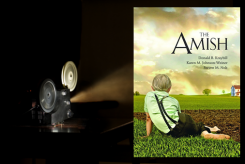Adult Services will be holding a Dinner & a Movie! event on Friday, February 14th at 6:30 p.m. in Mtg. Rm. B The movie will be one of this year's Oscar nominees: Judy starring Renee Zellweger will be shown and pizza will be served! Registration is required for this event and it begins on Monday, February 10th at 9:30 a.m.
Our Take On: "The Amish"
January’s JBF film, The Amish, drew a number of interested patrons who had never been to one of our film meetings before. That, in itself, was one of the many things we talked about after the film: how widespread and enduring the appeal of the Amish is for those of us they would think of as “the English”.
We talked about why they would fascinate “regular” people and it comes down to seeing a successful culture thrive within our culture, without adopting very much since the early 20th century. In many ways the Amish represent living history for folks, particularly in the Midwest, where their own families were traditionally farm families; and how life for both groups in the early 1900s would have been quite similar. Attendees identified with the home gardens and crafts that both Amish men and women are still producing as being things they could remember their grandparents or great-grandparents doing.
We were impressed with the way that the Amish live out their principles – particularly as they pertain to forgiveness. The film covered the horrendous murder of Amish children in their one room schoolhouse at the West Nickel Mines shooting. Wikipedia offers this summary of this tragedy:
On October 2, 2006, a shooting occurred at the West Nickel Mines School, an Amish one-room schoolhouse in the Old Order Amish community of Nickel Mines, a village in Bart Township, Lancaster County, Pennsylvania. Gunman Charles Carl Roberts IV took hostages and shot eight out of ten girls (aged 6–13), killing five, before committing suicide in the schoolhouse. The emphasis on forgiveness and reconciliation in the response of the Amish community was widely discussed in the national media. The West Nickel Mines School was torn down, and a new one-room schoolhouse, the New Hope School, was built at another location.
We had the full article at the discussion and shared further details about how the families of the victims reached out to the family of the killer. One Amish man held Roberts’ father in his arms as he cried and spoke with him for over an hour. The Amish families invited Roberts’ mother to the funerals for their children, and Amish leaders went to Roberts’ funeral to support the family there as well. All our attendees were impressed with how they followed their principles even under these harsh conditions.
We felt that the director did an impressive job of creating a seamless flow between the scenes of Amish life and the speakers he was interviewing. We all thought it had to be daunting to do a documentary where none of the people will let you interview them on camera. While the Amish allowed themselves to be photographed, they would not speak while being filmed.
This led to conversation about how a population living so deep within a very high tech society face constant challenges from the changes these outside groups bring. The Amish young adults can be overwhelmed by the range of choices available to them during their Rumspringa.
For Amish youth, the Rumspringa normally begins around the age of 14 to 16 and ends when a youth chooses baptism within the Amish church, or instead leaves the community… Not all Amish use this term (it does not occur in John A. Hostetler's extended discussion of adolescence among the Amish), but in sects that do, Amish elders generally view it as a time for courtship and finding a spouse. A popular view exists by which the period is institutionalized as a rite of passage, and the usual behavioral restrictions are relaxed, so that Amish youth can acquire some experience and knowledge of the non-Amish world. ~ Wikipedia
Another major challenge to current day Amish, is the fact that they are physically running out of viable farmland that is anywhere near their traditional settlements. This is leading to a quest for land to settle elsewhere; in the film, they were looking at land in the west. One of the challenges in a potential move there, is that they’d be moving from a place where there can be too much water to one where there might not be enough.
In the end, we were impressed with the strength of the Amish communities and found a sense of nostalgia for “how things used to be” that was positive and enviable. We acknowledged in the discussion afterwards that some aspects of Amish life that are not so positive were not included in the film, and that no one group can be seen only in a positive light. The film lightly addressed the practice of
“shunning” and alluded to how harsh that can be. We talked about the fact that PBS does have another documentary specifically about the Amish and shunning, and that it would be a great follow-up (possibly when we pick next year’s films)!
Click here to read what the PBS site has to say about this film.
















Add new comment